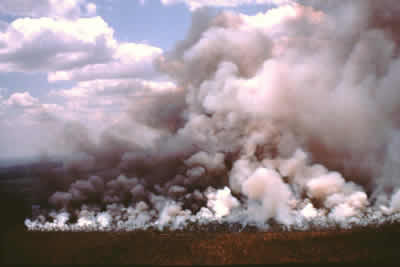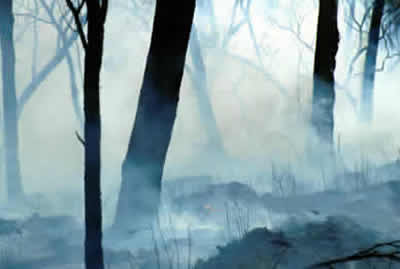Impacts of fire on landscape and atmosphere
In this section we consider the impacts of fire on interactions within ecosystems (biotic communities and their abiotic environment) and how fire alters the biogeochemical cycles within ecosystems.
We also take a more global perspective and consider carbon budgets, and the potential impact of fires on climate change.
Fire can also impact on hydrological cycles, although we do not discuss that here.
Nutrient dynamics
Burning facilitates the local redistribution of nutrients. Following a fire, some of the charred fragments of fuel remain in situ in the burnt area (approximately 7% of fine fuels), while other fragments are moved out of the direct area in smoke plumes, settling kilometres away.
There is however little agreement on the direct effect of fire on nutrient cycling. In the absence of fire, nutrients are primarily cycled through herbivory and decomposition by microbes. With fires there may be a flush of some nutrients (P, K, Ca and Mg), while losses of nitrogen (N) may be relatively high.
Much attention is focussed on nitrogen dynamics because nitrogen is considered the major limiting nutrient. Without nitrogen, there would be no life on earth. Australian soils are notoriously poor in nutrients such as nitrogen and phosphorus. This is in contrast to the comparably nutrient rich soils of Africa. The proportion of N that is volatized (i.e. returned as gas to the atmosphere) is linked to fire intensity.
Activity: Nitrogen & fires
How is the nitrogen budget affected by fire?
Cook (1994) discusses nutrient dynamics in the Australian savanna ecosystem and particularly the loss and replenishment of nitrogen in the presence of fire.
Summarise your reading by answering the question: How is the nitrogen budget affected by fire?
Reading:
Cook, G.D. (1994) The fate of nutrients during fires in a tropical savanna. Australian Journal of Ecology 19: 359-365.
Further reading
How does the impact of fire on nutrients relate to what you know about the soil nutrient status of each continent? Where might there be a cause for concern and why?
Aranibar, J.N., Macko, S.A., Anderson, I.C., A.L.F. Potgieter, Sowry, R. & Shugart, H.H. (2003) Nutrient cycling responses to fire frequency in the Kruger National Park (South Africa) as indicated by stable isotope analysis. Isotopes Environment and Health Studies 39: 141-158.
Another soil attribute affected by fire is soil organic matter (SOM). Repeated burning has been found to result in a decline in SOM because of (1) removal of vegetation which increases mineralisation of organic matter, (2) increased activity by soil microbes, (3) SOM combustion and (4) decreased inputs of organic matter as litter and above-ground biomass burn.
Changes in SOM have been linked to other aspects of ecosystem functioning, including soil infiltration rates and soil crusting. Soils in burnt areas crust more rapidly than in unburnt areas. This is because of a decrease in humus content and increase in clay dispersion. This is important because it can affect ecosystem functioning by altering water infiltration rate and mineralisation of organic matter.
Further reading
How does burning affect soil organic matter and crusting?
The following paper provides more detailed information on SOM, and changes in soil and hydrological processes following fire.
Reading:
Mills, A.J. & Fey, M.V. (2004) Frequent fires intensify soil crusting: physiochemical feedback in the pedoderm of long-term burn experiments in South Africa. Geoderma 121: 45-64.
Greenhouse gases and carbon budgets
The amount of burning biomass and production of trace gases and aerosol particles has important implications for global climate. More than 80% of the world’s burning of biomass occurs in the tropics, primarily because of the proliferation of savanna fires.

Aerial smoke from a savanna fire

Ground smoke from a savanna fire
The most important emissions include:
- The greenhouse gases: carbon dioxide (CO2), methane (CH4) and nitrous oxide (N2O)
- Chemically active gases that lead to formation of ozone
- Particulate matter that can lead to air pollution affecting human health and well-being
Not only can fires cause changes in CO2 levels which can lead to shifts in the carbon (C) balance, and enhanced emissions of greenhouse gases, but increases in atmospheric CO2 levels, and global warming can feed-back on fire regimes and fire severity.
As outlined in the Fire Fundamentals section, regional climatic and local meterological conditions can influence fire behaviour. Therefore with a change in climate predicted with global warming it is important to begin to explore this relationship.
What is global warming?
The global energy budget depends on the balance between incoming solar radiation and outgoing long-wave radiation. The greenhouse effect is produced when an increase in greenhouse gases forces an increase in global surface temperatures because there is a reduction in outgoing radiation. Gases such as carbon dioxide, methane, nitrous oxides and chlorofluorocarbons (CFCs) trap the sun’s heat in the Earth’s atmosphere.
Although global warming has occurred in the distant past as a result of natural influences, the term is most often used to refer to the warming predicted to occur as a result of increased emissions of greenhouse gases.
Further reading
Have a look at the following website Fire and Climate Change: General Information which focuses on a Canadian study looking at the impact of climate change on fire regimes in boreal ecosystems.
The Intergovernmental Panel on Climate Change (IPCC) modeled several climate change scenarios which indicate a rise in the average global temperature, and the CSIRO Climate Change Research Program has modeled regional climate change scenarios for Australia. CSIRO scenarios predict the potential for climate change to modify fire behaviour though changes in average temperature and precipitation. It is important to bear in mind that predictions vary, and there is a great deal of uncertainty associated with the prediction of climate change.
Fires in Australian savannas contribute to the greenhouse gas production of Australia. Regionally, fires can account for nearly a third of anthropogenic CO2 equivalent emissions.
Land management practises like burning are important because they can affect the amount of CO2 in the atmosphere. Vegetation has the potential to sequester (or withdraw) carbon from the atmosphere through photosynthesis. Changes in tree cover can influence the relative contribution of vegetation to the sequestration process. Unlike carbon stored in soils, carbon stored in woody vegetation can vary from season to season, and year to year as vegetation cover varies.
CO2 emissions can vary depending on fire intensity, with greater release of CO2 from late season fires than early dry season fires. This means that fire regimes have the potential to greatly impact greenhouse gas emissions and carbon storage.
Further reading
The following paper looks at the potential of the Australian savanna ecosystem to act as carbon sinks.
How might fires affect the potential of savannas to act as carbon sinks? What are the implications of the current regime of very high frequency fires?
Reading:
Williams, R.J., Hutley, L.B., Cook, G.D., Russell-Smith, J., Edwards, A. & Chen, X.Y. (2004) Assessing the carbon sequestration potential of mesic savannas in the Northern Territory, Australia: approaches, uncertainties and potential impacts of fire. Functional Plant Biology 31: 415-422.
Further reading
Sometimes, fires covering only a relatively small area of the world can have a very large impact on the rate of global carbon release. This was the case with the 1997 peat fires which occurred in the wet tropical forest ecosystem in Indonesia. Schimel & Baker (2002) investigate carbon loss due to these fires.
Reading:
Schimel, D. & Baker, D. (2002) The wildfire factor. Nature 420: 29-30.
![]()